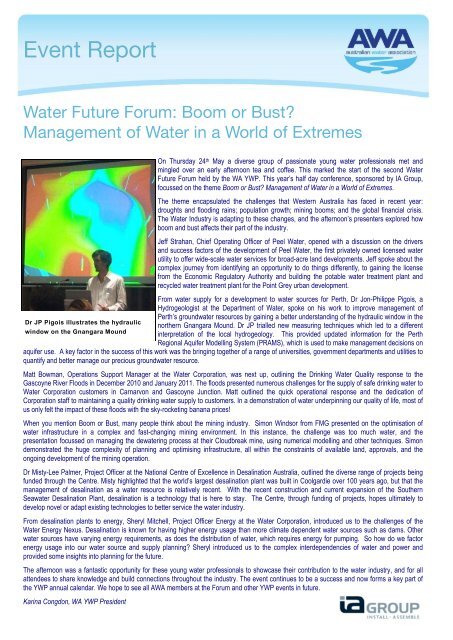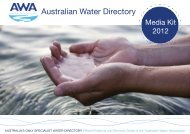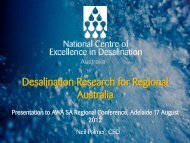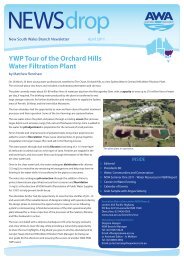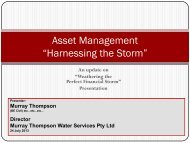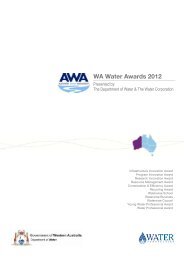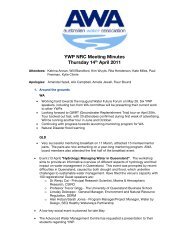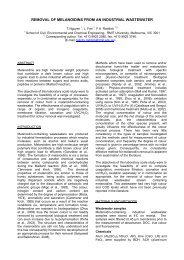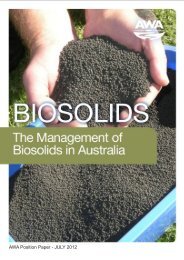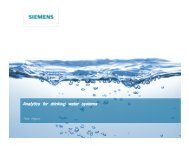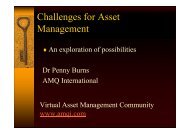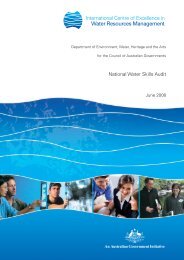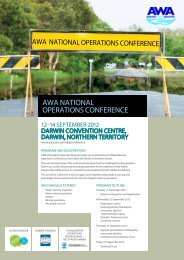Thoughts from your WA President - Australian Water Association
Thoughts from your WA President - Australian Water Association
Thoughts from your WA President - Australian Water Association
You also want an ePaper? Increase the reach of your titles
YUMPU automatically turns print PDFs into web optimized ePapers that Google loves.
Event Report<strong>Water</strong> Future Forum: Boom or Bust?Management of <strong>Water</strong> in a World of ExtremesOn Thursday 24 th May a diverse group of passionate young water professionals met andmingled over an early afternoon tea and coffee. This marked the start of the second <strong>Water</strong>Future Forum held by the <strong>WA</strong> YWP. This year’s half day conference, sponsored by IA Group,focussed on the theme Boom or Bust? Management of <strong>Water</strong> in a World of Extremes.The theme encapsulated the challenges that Western Australia has faced in recent year:droughts and flooding rains; population growth; mining booms; and the global financial crisis.The <strong>Water</strong> Industry is adapting to these changes, and the afternoon’s presenters explored howboom and bust affects their part of the industry.Jeff Strahan, Chief Operating Officer of Peel <strong>Water</strong>, opened with a discussion on the driversand success factors of the development of Peel <strong>Water</strong>, the first privately owned licensed waterutility to offer wide-scale water services for broad-acre land developments. Jeff spoke about thecomplex journey <strong>from</strong> identifying an opportunity to do things differently, to gaining the license<strong>from</strong> the Economic Regulatory Authority and building the potable water treatment plant andrecycled water treatment plant for the Point Grey urban development.From water supply for a development to water sources for Perth, Dr Jon-Philippe Pigois, aHydrogeologist at the Department of <strong>Water</strong>, spoke on his work to improve management ofPerth’s groundwater resources by gaining a better understanding of the hydraulic window in theDr JP Pigois illustrates the hydraulicnorthern Gnangara Mound. Dr JP trialled new measuring techniques which led to a differentwindow on the Gnangara Mound interpretation of the local hydrogeology. This provided updated information for the PerthRegional Aquifer Modelling System (PRAMS), which is used to make management decisions onaquifer use. A key factor in the success of this work was the bringing together of a range of universities, government departments and utilities toquantify and better manage our precious groundwater resource.Matt Bowman, Operations Support Manager at the <strong>Water</strong> Corporation, was next up, outlining the Drinking <strong>Water</strong> Quality response to theGascoyne River Floods in December 2010 and January 2011. The floods presented numerous challenges for the supply of safe drinking water to<strong>Water</strong> Corporation customers in Carnarvon and Gascoyne Junction. Matt outlined the quick operational response and the dedication ofCorporation staff to maintaining a quality drinking water supply to customers. In a demonstration of water underpinning our quality of life, most ofus only felt the impact of these floods with the sky-rocketing banana prices!When you mention Boom or Bust, many people think about the mining industry. Simon Windsor <strong>from</strong> FMG presented on the optimisation ofwater infrastructure in a complex and fast-changing mining environment. In this instance, the challenge was too much water, and thepresentation focussed on managing the dewatering process at their Cloudbreak mine, using numerical modelling and other techniques. Simondemonstrated the huge complexity of planning and optimising infrastructure, all within the constraints of available land, approvals, and theongoing development of the mining operation.Dr Misty-Lee Palmer, Project Officer at the National Centre of Excellence in Desalination Australia, outlined the diverse range of projects beingfunded through the Centre. Misty highlighted that the world’s largest desalination plant was built in Coolgardie over 100 years ago, but that themanagement of desalination as a water resource is relatively recent. With the recent construction and current expansion of the SouthernSeawater Desalination Plant, desalination is a technology that is here to stay. The Centre, through funding of projects, hopes ultimately todevelop novel or adapt existing technologies to better service the water industry.From desalination plants to energy, Sheryl Mitchell, Project Officer Energy at the <strong>Water</strong> Corporation, introduced us to the challenges of the<strong>Water</strong> Energy Nexus. Desalination is known for having higher energy usage than more climate dependent water sources such as dams. Otherwater sources have varying energy requirements, as does the distribution of water, which requires energy for pumping. So how do we factorenergy usage into our water source and supply planning? Sheryl introduced us to the complex interdependencies of water and power andprovided some insights into planning for the future.The afternoon was a fantastic opportunity for these young water professionals to showcase their contribution to the water industry, and for allattendees to share knowledge and build connections throughout the industry. The event continues to be a success and now forms a key part ofthe YWP annual calendar. We hope to see all A<strong>WA</strong> members at the Forum and other YWP events in future.Karina Congdon, <strong>WA</strong> YWP <strong>President</strong>Jul-122


